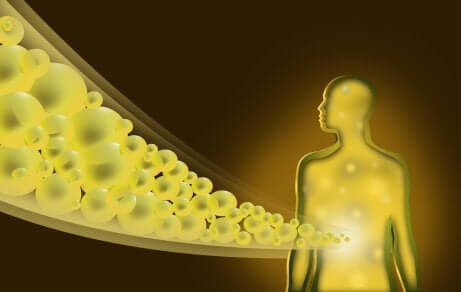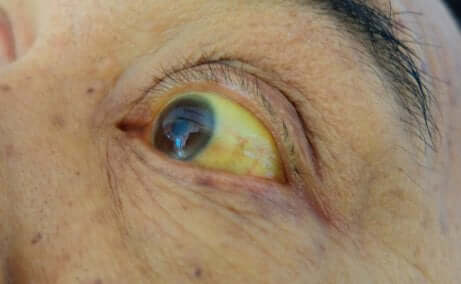Gilbert's Syndrome: Symptoms and Treatment

According to statistics, Gilbert’s syndrome is a condition present in 1% of the world’s population. However, it occurs between 5 and 10% of some populations. It’s a hereditary problem, which normally appears in adults between ages 20 and 30.
Gilbert’s syndrome is most often found during a routine blood test. The disease was described for the first time in 1902, by Augustin Nicolas Gilbert and Pierre Lereboullet. In fact, this is where it got its name.
Gilbert’s syndrome is a benign, but chronic condition. It’s due to a hereditary genetic mutation. Many people with this disease don’t know they have it, since it doesn’t have obvious symptoms.
Gilbert’s syndrome

Gilbert’s syndrome is an inherited condition, characterized by high levels of bilirubin in the blood. Also, it’s known as constitutional liver failure and familial non-hemolytic jaundice.
It’s a dysfunction where the liver doesn’t process bilirubin like it should. However, Gilbert’s syndrome is harmless. We should mention that bilirubin is a substance that comes from aging red blood cells, and the liver processes it.
Normally, the body flushes out bilirubin through fecal matter and urine. When bilirubin levels rise, the liver can’t process it properly. Due to this, the skin and tissues absorb this substance.
Check this out: Everything You Need to Know About Liver Detox Diets
Causes
Gilbert’s syndrome is a consequence of the reduced ability of hepatocytes (liver cells) to excrete bilirubin. When red blood cells age and deteriorate, they release hemoglobin. This metabolizes and formes a group of substances called “Heme.”
Heme first transforms into biliverdin, then into something like a first version of bilirubin. This is called “unconjugated” or indirect. Then, when it passes through the liver and combines with glucuronic acid, it causes a reaction that results in direct or conjugated bilirubin.
If the process happens properly, the bilirubin becomes water soluble, and leaves the body in the bile. However, there’s a mutated gene in some people that prevents the normal production of the enzyme that regulates bilirubin production. This then leads to Gilbert’s syndrome.
Symptoms and diagnosis of Gilbert’s syndrome

Additionally, another symptom is the inability to process some substances, especially drugs. In particular, some people with this disease have an increased risk of toxicity from the drug paracetamol.
However, there are no other recognizable symptoms. When people with this condition have a blood test, it shows high levels of indirect bilirubin, while direct bilirubin levels are normal. Also, liver tests are normal, and there are no other abnormalities on imaging tests.
Check this out: 6 Diets that Help Care for Your Liver Health
Treatment
Gilbert’s syndrome doesn’t require any type of treatment, since it doesn’t cause damage. Therefore, it’s considered benign. This dysfunction doesn’t affect quality of life, and it often goes unnoticed.
In addition, it doesn’t cause complications, and doesn’t require a special diet. The only thing you need to watch is taking certain drugs, like paracetamol.
As we already mentioned, with Gilbert’s syndrome, there’s an increased risk of liver effects from ingesting some drugs. Apart from this, a person with this condition can lead a completely normal life, without needing special care.
Jaundice can appear and disappear several times throughout the person’s life, without posing any health risks. Then, once you have the diagnosis, you don’t need any type of medical follow-up for this condition.
All cited sources were thoroughly reviewed by our team to ensure their quality, reliability, currency, and validity. The bibliography of this article was considered reliable and of academic or scientific accuracy.
- Delgado Peña, Y., Fleta Zaragozano, J., Lázaro Almarza, A., Gracía Casanova, M., Jiménez Vidal, A., & Olivares López, J. (2007). Síndrome de Gilbert: estudio de 12 observaciones y revisión de la bibliografía médica. Acta Pediátrica Española, 65(8), 404-408.
- Thoguluva Chandrasekar V, John S. Gilbert Syndrome. [Updated 2019 Apr 11]. In: StatPearls [Internet]. Treasure Island (FL): StatPearls Publishing; 2019 Jan-. Available from: https://www.ncbi.nlm.nih.gov/books/NBK470200/
- Qian JD, Hou FQ, Wang TL, Shao C, Wang GQ. Gilbert syndrome combined with prolonged jaundice caused by contrast agent: Case report. World J Gastroenterol. 2018;24(13):1486–1490. doi:10.3748/wjg.v24.i13.1486
- Wagner, K. H., Shiels, R. G., Lang, C. A., Seyed Khoei, N., & Bulmer, A. C. (2018, February 17). Diagnostic criteria and contributors to Gilbert’s syndrome. Critical Reviews in Clinical Laboratory Sciences. Taylor and Francis Ltd. https://doi.org/10.1080/10408363.2018.1428526
This text is provided for informational purposes only and does not replace consultation with a professional. If in doubt, consult your specialist.








